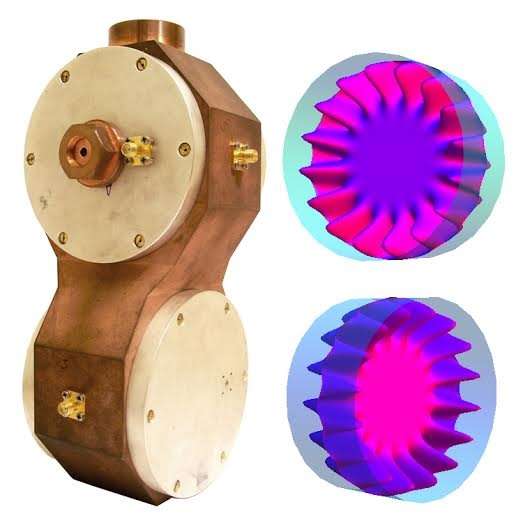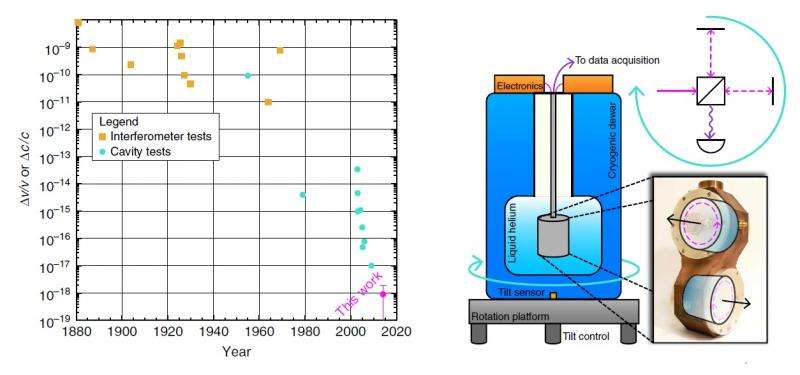(Left) Photo of the orthogonal sapphire crystal mount, with (right) simulations of the electromagnetic resonant mode patterns. A frequency variation in the resonance would indicate a variation in the speed of light. Credit: Stephen R. Parker, The University of Western Australia
(Phys.org)—The laws of physics are the same no matter which direction you're facing or how fast you're moving—it's such an intuitive concept that most people probably don't know that it has a name: Lorentz symmetry. Over the past several decades, physicists have been testing Lorentz symmetry at ever-higher degrees of precision, as violations of the foundational property are predicted by a number of proposals that aim to unify the two major theories of modern physics: general relativity and the standard model of particle physics.
Now in a new paper, physicists have reported the most precise test to date of Lorentz symmetry for the photon by looking for variations in the speed of light, but have found no violations. The study, by Moritz Nagel at the Humboldt-University of Berlin, Stephen Parker at The University of Western Australia, and their coauthors, is published in a recent issue of Nature Communications.
Although the term "Lorentz symmetry" is named for the Dutch physicist Hendrik Lorentz and the fact that it is a symmetry of spacetime, it may be better thought of as a property about relativity, and in fact it is a cornerstone of Einstein's special relativity theory. According to special relativity, there is no absolute space or absolute time. So if two objects are moving relative to each other in empty space, it would actually be impossible for an observer to tell their absolute velocities—maybe only one of the objects was moving and the other was stationary, for example, but you wouldn't know which was which because their movements are relative to each other, not to any external reference frame (assuming the reference frame is non-accelerating).
One important consequence of Lorentz symmetry is that the speed of light is invariant, or a constant in vacuum. The fact that photons in vacuum always move at a speed of just under 300,000 km per second is intimately connected to the concepts in special relativity. In the new study, the researchers performed an experiment that attempted to measure any tiny frequency variation of light, which would indicate a variation in the speed of light.
(Left) Historical overview of Michelson-Morley-style tests of Lorentz symmetry for the photon. Interferometer tests measure fractional shifts in the speed of light, while cavity-based tests measure fractional changes in the frequency of light. (Right) Experimental set-up of the cavity-based test, with the two crystal axes aligned at right angles. The original Michelson-Morley interferometer test is shown in the top right corner for comparison. Credit: Moritz Nagel, et al. ©2015 Macmillan Publishers Limited
Their experiment consists of a highly sensitive Michelson-Morley cavity test, which is an updated version of the seminal Michelson-Morley interferometer used in the late 1800s to measure the speed of light in the search for an "aether" that pervaded the universe (for which, of course, no evidence was found). While an interferometer is based on reflecting light back and forth between mirrors, cavity tests consist of both optical and electrical components. The cavity test here involves two cavities containing sapphire crystals. The researchers excited an electromagnetic resonance in the crystals at a specific frequency, and supercooled them with liquid helium to stabilize the frequency and improve sensitivity. Like the mirrors of the interferometer, the cavities are carefully aligned orthogonal (at right angles) to each other to detect any tiny change in the speed of light along different axes. In the case of the cavities, a change in the speed of light would induce a change in the resonance frequency of the crystals. But after analysis of a full year of data, no such change was found.
"This is the first direct test of polarization-independent effects for Lorentz invariance violations of the photon that has reached the level of the Planck-suppressed electroweak unification scale," Parker told Phys.org. "The energy scale of electroweak unification (about 100 GeV) suppressed by the Planck scale (about 1.2 x 1019 GeV) gives the dimensionless ratio of about 8 x 10-18, so perhaps naively one might expect to start seeing Lorentz symmetry of the photon being broken in this regime, yet we didn't see any evidence for this."
By providing the strongest evidence yet that the speed of light is a constant, the results further verify that Lorentz symmetry is a basic property of nature. Like other experimental results, the speed of light does not seem to depend on the orientation of the laboratory (rotation invariance) or its velocity though space (boost invariance). Since the precision of the new test (10-18) is an order of magnitude better than that of previous tests of Lorentz symmetry of the photon, it does allow the scientists to improve the bounds on the nine rotational and boost isotropies of the speed of light by a factor of four.
These improved bounds could prove very useful for experimentally testing theories that unify general relativity and the standard model while predicting Lorentz symmetry violations. Some of these theories, for example, include string theory-based models and quantum gravity theories, among others. Although these theories are complex, one reason for the predicted Lorentz symmetry violation is that, in order to "quantize" gravity, there must be a minimum length scale—an absolute distance that is difficult to reconcile with the relative nature of Lorentz symmetry.
In the near future, scheduled upgrades to the Michelson-Morley cavity experiment are expected to improve the frequency stability, reduce the noise, and remove other interfering effects, allowing for even more precise tests.
"We're in the process of upgrading our experimental setup to reduce the influence of systematic noise," Parker said. "For example, we've now installed better cryogenic magnetic shielding around our sapphire oscillators. At the same time, we're undertaking research to improve the fundamental frequency stability performance of the oscillators, and we're developing a pair of cryogenic optical resonators. These optical resonators will be added in to the same cryogenic environment as the microwave oscillators, allowing us to make comparisons between them. So we will be improving the raw sensitivity of the experiment and also the reach of this work, as we'll be able to search for different types of Lorentz invariance violation effects, too."
More information: Moritz Nagel, et al. "Direct terrestrial test of Lorentz symmetry in electrodynamics to 10-18." Nature Communications. DOI: 10.1038/ncomms9174
Journal information: Nature Communications
© 2015 Phys.org
























